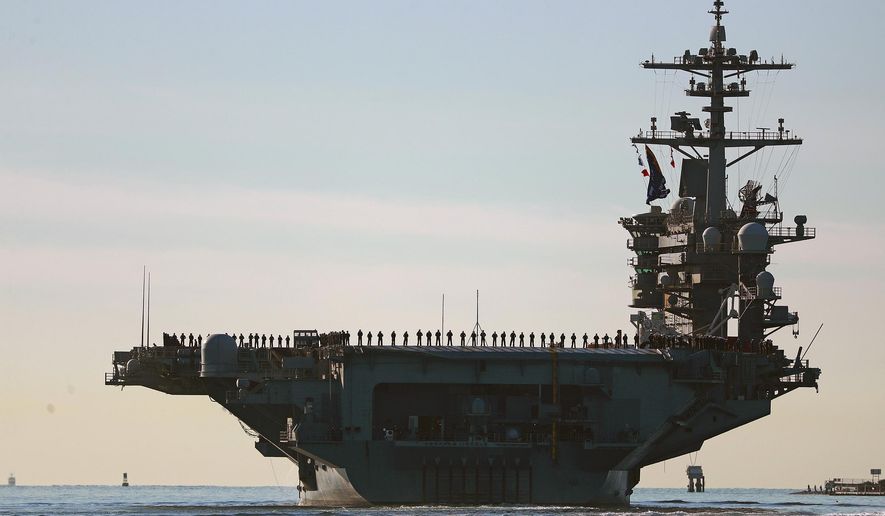A version of this story appeared in the daily Threat Status newsletter from The Washington Times. Click here to receive Threat Status delivered directly to your inbox each weekday.
The U.S. military for the first time in decades has no aircraft carrier strike groups in the Indo-Pacific region, despite mounting tensions with China over disputed South China Sea islands, the Taiwan Strait, and a recent Chinese air incursion near Japan.
The Pentagon recently ordered the USS Abraham Lincoln to speed up its deployment from the Pacific to the Middle East to be ready for a potential conflict with Iran. Earlier the USS Theodore Roosevelt, like the Lincoln based in San Diego, was sent to the Middle East.
Both warships are currently in the Gulf of Oman, USNI reported Monday.
The redeployment has left the U.S. without a carrier in the region for the first time since 2001. Two other Pacific-based carriers, the USS Ronald Reagan and the USS Carl Vinson, remain docked on the West Coast.
Navy officials said the San Diego-based USS George Washington is headed for Japan but will not be on station until next month.
The Reagan is now in Bremerton, Washington state and the Vinson is in San Diego.
The 11 U.S. carriers remain a premier power-projection capability despite their vulnerability to anti-ship missiles. The carriers deploy scores of warplanes that can conduct both land and sea strikes.
Carrier strike groups normally include several guided-missile warships and support vessels along with a submarine. The groups can include up to 7,500 sailors and Marines.
Air Force Maj. Gen. Pat Ryder told reporters earlier this month that the lack of a carrier strike group in the Pacific has not lessened the military’s defense posture in the region.
The surge of forces to the Middle East shows the flexibility of the military to move forces “where we need them, when we need them,” he said. “But I can tell you and rest assured that the Indo-Pacific has a significant number of U.S. forces to support our commitments toward that end,” he said.
Gen. Ryder declined to say on Tuesday how long the carrier gap would last.
“I’m not going to get into deployment timelines for operational security reasons, but the bottom line is we can walk and chew gum at the same time, he said.
Lt. Cmdr. Christina Hough, spokeswoman for the Pacific Fleet, said fleet forces include several warships operating across the Pacific that are working to promote adherence to a rules-based international order.
The warships also represent a presence and have the flexibility to rapidly respond to “persistent and emergent missions,” she told The Washington Times in a statement.
“In addition to cruisers and destroyers, these include the forward deployment of the America and Boxer amphibious readiness groups and embarked Marine expeditionary units, whose forward presence, alongside our allies and partners, demonstrates our collective resolve to ensure security and stability in the region,” Cmdr. Hough said.
But retired Navy Capt. Jim Fanell, former director of intelligence for the Pacific Fleet, said the absence of a carrier group in the region is dangerous, noting it is the first time it has occurred since 2001, when the Japan-based USS Kitty Hawk was deployed to the Persian Gulf.
Since then both Democratic and Republican administrations have maintained at least one carrier strike group in the western Pacific to provide a strong deterrence to aggressive Chinese military activities or for a possible North Korean contingency, he said.
The current gap “sends a clear and unambiguous message to Beijing that the Biden-Harris administration is unlikely to intervene to help protect America’s national interest in Asia or those of our allies such as Japan, [the Philippines] or even Taiwan,” Capt. Fanell said.
He compared the gap to the decision by the Obama administration in 2012 not to respond forcefully to China’s seizure of the disputed Scarborough Shoal in the South China Sea, saying it only encouraged the Chinese military to build up more strategically located islands in the sea that are now armed with anti-ship and anti-aircraft missiles.
“Wherever the U.S. leaves a vacuum, [China] fills it with their military forces,” Capt. Fanell said. An Indo-Pacific Command spokeswoman did not immediately respond to a request for comment on the U.S. presence in the region.
Defense Secretary Lloyd Austin ordered the redeployment earlier this month and last week directed the warship to speed up its deployment following a heavy exchange of missile fire between Israel and Iran-backed Hezbollah forces in Lebanon.
The Reagan conducted what the Navy calls a “carrier swap” with the Washington on Aug. 1 in San Diego. The new home port for the Reagan will be Bremerton, Washington, while the Washington will take over as the sole forward-deployed carrier in Yokosuka, Japan. Several other Pacific-based U.S. carriers are in port or undergoing maintenance.
The lack of carriers in the Indo-Pacific comes as China and the Philippines continue to engage in a series of confrontations over disputed reefs in the Spratlys, which Manila claims as its territory and China calls its maritime domain.
Tensions also flared further north this week after China for the first time flew a reconnaissance aircraft within Japan’s airspace.
Japan Chief Cabinet Secretary Yoshimasa Hayashi said the incursion of the Chinese military aircraft was “totally unacceptable.”
On Tuesday, Rear Adm. Andrew Sugimoto, deputy commander of the U.S. Coast Guard Pacific Area, condemned what he called China’s aggressive ramming actions against the Philippines, the Philippine News Agency reported.
The ramming violated international law, Adm. Sugimoto said in a virtual press conference.
“It’s a little astounding to say that ’I’m going to break the law in order to uphold the law.’ It just doesn’t make sense, and I think most nations out there see that as unsafe and unprofessional conduct, which only highlights and further emphasizes the bullying that is going on,” he said.
• Bill Gertz can be reached at bgertz@washingtontimes.com.




Please read our comment policy before commenting.